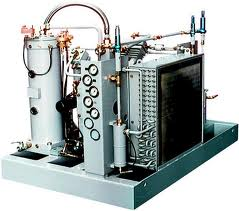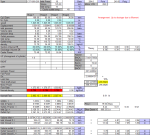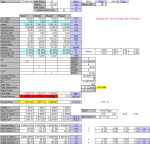CNG compressor design.xlsx

Description
A diaphragm compressor (also known as a membrane compressor) is a variant of the conventional reciprocating compressor. The compression of gas occurs by the movement of a flexible membrane, instead of an intake element. The back and forth movement of the membrane is driven by a rod and a crankshaft mechanism. Only the membrane and the compressor box come in contact with the gas being compressed. Diaphragm compressors are used for hydrogen and compressed natural gas (CNG) as well as in a number of other applications.
Calculation Reference
Compressor Design
CNG Compressed Natural Gas
Perry's Chemical Engineers Handbook
The design of a CNG (compressed natural gas) compressor involves several considerations, including the desired flow rate, pressure, efficiency, and safety. Here are some of the key steps involved in the design process:
-
Determine the flow rate: The first step in designing a CNG compressor is to determine the desired flow rate of compressed gas. This will depend on the application and the amount of gas needed.
-
Select the compressor type: There are several types of compressors that can be used for CNG, including reciprocating, rotary screw, and centrifugal compressors. Each type has its own advantages and disadvantages in terms of efficiency, cost, and maintenance requirements.
-
Determine the compression ratio: The compression ratio is the ratio of the discharge pressure to the suction pressure. This will depend on the desired pressure of the compressed gas and the properties of the gas being compressed.
-
Select the motor: The compressor will require a motor to drive it, and the size and power of the motor will depend on the flow rate and compression ratio.
-
Consider safety: CNG is highly flammable and requires special safety considerations. The compressor should be designed with safety features such as pressure relief valves and fire suppression systems.
-
Determine the compressor layout: The compressor layout will depend on the available space and the desired flow rate. The compressor may be housed in a building or installed outdoors, and may require additional equipment such as cooling systems or storage tanks.
-
Consider maintenance requirements: The compressor will require regular maintenance, including oil changes, filter replacements, and inspections. The design should take into account accessibility for maintenance and ease of servicing.
Overall, the design of a CNG compressor will depend on a variety of factors, including the desired flow rate, pressure, efficiency, and safety. It is important to work with experienced engineers and manufacturers to ensure that the design meets all necessary requirements and standards.
Calculation Preview
Full download access to any calculation is available to users with a paid or awarded subscription (XLC Pro).
Subscriptions are free to contributors to the site, alternatively they can be purchased.
Click here for information on subscriptions.




